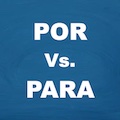Welcome 😊 to our grammar lesson on Spanish Possessive adjectives and pronouns (“Adjetivos y pronombres posesivos”).
Possessives indicate possession. In other words, who owns something. They are equivalent to the English my, mine, your, yours, his…

By the end of this lesson, you will be able to understand these words and use them correctly in sentences.
You will also find a Quiz and an Exercise to practice.
Short forms
There are 2 types of possessives we need to study. We will call them short forms and long forms.
The following table shows the short forms:
English Singular Plural
my mi mis
your tu tus
our nuestro, nuestra nuestros, nuestras
your (of you guys) vuestro, vuestra vuestros, vuestras
his, her, its, their, polite your su sus
Notes:
- All short forms need to match the number of the owned thing (singular or plural).
- nuestro and vuestro need to also match the gender of the owned thing (masculine or feminine).
We can only place short forms right before a noun (the owned thing):
Mi camiseta es azul.
My t-shirt is blue.Tus muñecas son lindas.
Your dolls are pretty. (“tus” is plural, in order to match the owned thing: “muñecas”)Su coche es alemán.
His/her/their/your(polite) car is german.¿Te gustan nuestras sillas?
Do you like our chairs? (“nuestras” is feminine plural, in order to match the owned thing: “sillas”)
Long forms
The following table shows the long forms:
English Masculine Singular Feminine Singular Masculine Plural Feminine Plural
mine mío mía míos mías
yours tuyo tuya tuyos tuyas
ours nuestro nuestra nuestros nuestras
yours (of you guys) vuestro vuestra vuestros vuestras
his, her, its, theirs, polite yours suyo suya suyos suyas
Note:
- All long forms need to match both the number and the gender of the owned thing.
We can place the long forms anywhere in the sentence, except right before a noun (the owned thing):
La camiseta es mía.
The t-shirt is mine.Juan es un amigo mío.
Juan is a friend of mine.Las fresas son tuyas.
The strawberries are yours.El coche es suyo.
The car belongs to him/her/them/you(polite).Las mochilas son vuestras.
The backpacks belong to you guys.
It is possible to place a Definite Article (“el-la-los-las”) before a long form.
In this case, the long form represents a noun that we choose not to mention. The reason we don’t mention the noun might be because we have done it already, and we don’t want to keep repeating it:
El mío es verde.
Mine is green. (“El mío” represents a noun that is not mentioned. For example, it could be “mi coche”, my car).Mi impresora es más moderna que la tuya.
My printer is more modern than yours. (here, obviously “la tuya” represents “tu impresora”, your printer. We just don’t want to mention “impresora” again)Vuestros caballos son rápidos, y los nuestros también.
Your horses are fast, and so are ours. (“los nuestros” obviously represents “nuestros caballos”, our horses)
The ambiguity of “su, suyo…”
Each possessive form that begins with “su-“ (su, sus, suyo, suya, suyos, suyas) can mean different things (his, her, their, etc)
Then, how do we know exactly what it means in a specific sentence? We know it from the context.
Imagine we read the following sentence without any context:
Su casa es blanca.
… there is no way of knowing if that means “his house”, “her house”, “its house”, “their house” or “your (polite) house”.
However if we read:
Esta es María. Su casa es blanca.
This is María. Her house is white.
Then it is clear we mean “her”, because María is a woman.
So remember: for all possessive forms that begin with “su-“, context is key.
Practice
Quiz
Take this short Quiz about possessive adjectives and pronouns:
Exercise 1
In the following sentences and short dialogs, fill the gaps using possessive adjectives and pronouns. Don’t forget to match the possessive’s gender and number to the noun when necessary.
Click on the gray spaces to see the solutions:
1) ¿Este móvil es tuyo ?
Is this cellphone yours?
2) Sí, es mi móvil.
Yes, it is my cellphone.3) Las gafas son de Ana. Son suyas .
The glasses belong to Ana. They belong to her.4) El libro es de Ana. Es su libro.
The book belongs to Ana. It is her book.5) Los libros son de Ana y Laura. Son suyos .
The books belong to Ana and Laura. They belong to them.
Exercise 2
More sentences!:
6) ¿Esta botella es tuya ?
Is this bottle yours?
7) Sí, es mi botella. Es mía .
Yes, it is my bottle. It is mine.8) ¿El lápiz es vuestro ?
Does the pencil belong to you guys?
9) Sí, es nuestro .
Yes, it belongs to us.10) Mi casa es más grande que la tuya .
My house is bigger than yours.








